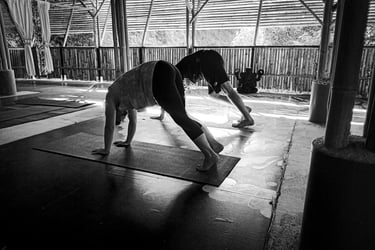A Challenging Practice Staple
Stiff shoulders can cause us to round our back or shift our body too far forward. It's common for some to roll their shoulders and upper arms inwards, folding the shoulders towards the neck and ears. This creates tension and makes it harder to hold the pose.
A Practise Staple
Tight hamstrings can also pose a challenge, making it difficult to maintain straight legs while keeping the hips high.
Despite these challenges, the Downward Dog is a staple in a beginner's routine (and our standing sequence) because it engages multiple parts of the body. This pose involves the wrists, shoulders, spine, hips, hamstrings, and calves. It stretches the entire back of the body at once, including the upper and middle back, muscles around the buttocks, hamstrings, calves and ankles.


The Downward Facing Dog may feel exceptionally challenging and awkward for some, especially for those with stiff shoulders or hamstrings.
Inversion
This upside-down posture promotes spinal decompression and is useful for relieving back pain. When performed consistently, it helps alleviate stiffness and tension in the neck and back.
Regular practice helps us build upper body strength that helps make the benefits more accessible to us.
Other Benefits
Beyond improved circulation, the pose :
strengthens the pelvic floor and lower abdominals.
strengthens the deep spinal muscles
lengthens the hamstrings and back of the legs.
improves postural awareness around the pelvis and hips.
More Insights
